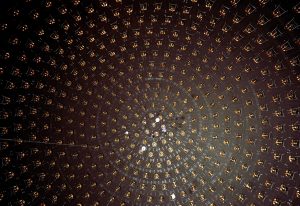MiniBooNE scientists demonstrate a new way to probe the nucleus with muon neutrinos.

This interior view of the MiniBooNE detector tank shows the array of photodetectors used to pick up the light particles that are created when a neutrino interacts with a nucleus inside the tank. Photo: Reidar Hahn
Tiny particles known as neutrinos are an excellent tool to study the inner workings of atomic nuclei. Unlike electrons or protons, neutrinos have no electric charge, and they interact with an atom’s core only via the weak nuclear force. This makes them a unique tool for probing the building blocks of matter. But the challenge is that neutrinos are hard to produce and detect, and it is very difficult to determine the energy that a neutrino has when it hits an atom.
This week a group of scientists working on the MiniBooNE experiment at the Department of Energy’s Fermilab reported a breakthrough: They were able to identify exactly-known-energy muon neutrinos hitting the atoms at the heart of their particle detector. The result eliminates a major source of uncertainty when testing theoretical models of neutrino interactions and neutrino oscillations.
“The issue of neutrino energy is so important,” said Joshua Spitz, Norman M. Leff assistant professor at the University of Michigan and co-leader of the team that made the discovery, along with Joseph Grange at Argonne National Laboratory. “It is extraordinarily rare to know the energy of a neutrino and how much energy it transfers to the target atom. For neutrino-based studies of nuclei, this is the first time it has been achieved.”
To learn more about nuclei, physicists shoot particles at atoms and measure how they collide and scatter. If the energy of a particle is sufficiently large, a nucleus hit by the particle can break apart and reveal information about the subatomic forces that bind the nucleus together.
But to get the most accurate measurements, scientists need to know the exact energy of the particle breaking up the atom. That, however, is almost never possible when doing experiments with neutrinos.
Like other muon neutrino experiments, MiniBooNE uses a beam that comprises muon neutrinos with a range of energies. Since neutrinos have no electric charge, scientists have no “filter” that allows them to select neutrinos with a specific energy.
MiniBooNE scientists, however, came up with a clever way to identify the energy of a subset of the muon neutrinos hitting their detector. They realized that their experiment receives some muon neutrinos that have the exact energy of 236 million electronvolts (MeV). These neutrinos stem from the decay of kaons at rest about 86 meters from the MiniBooNE detector emerging from the aluminum core of the particle absorber of the NuMI beamline, which was built for other experiments at Fermilab.
Energetic kaons decay into muon neutrinos with a range of energies. The trick is to identify muon neutrinos that emerge from the decay of kaons at rest. Conservation of energy and momentum then require that all muon neutrinos emerging from the kaon-at-rest decay have to have exactly the energy of 236 MeV.
“It is not often in neutrino physics that you know the energy of the incoming neutrino,” said MiniBooNE co-spokesperson Richard Van De Water of Los Alamos National Laboratory. “With the first observation by MiniBooNE of monoenergetic muon neutrinos from kaon decay, we can study the charged current interactions with a known probe that enable theorists to improve their cross section models. This is important work for the future short- and long-baseline neutrino programs at Fermilab.”
This analysis was conducted with data collected from 2009 to 2011.
“The result is notable,” said Rex Tayloe, co-spokesperson of the MiniBooNE collaboration and professor of physics at Indiana University Bloomington. “We were able to extract this result because of the well-understood MiniBooNE detector and our previous careful studies of neutrino interactions over 15 years of data collection.”
Spitz and his colleagues already are working on the next monoenergetic neutrino result. A second neutrino detector located near MiniBooNE, called MicroBooNE, also receives muon neutrinos from the NuMI absorber, 102 meters away. Since MicroBooNE uses liquid-argon technology to record neutrino interactions, Spitz is optimistic that the MicroBooNE data will provide even more information.
“MicroBooNE will provide more precise measurements of this known-energy neutrino,” he said. “The results will be extremely valuable for future neutrino oscillation experiments.”
The MiniBooNE result was published in the April 6, 2018, issue of Physical Review Letters. This research was supported by the U.S. Department of Energy Office of Science.



